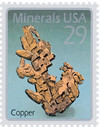
# 2701 - 1992 29c Minerals: Copper
US#2701
1992 Copper
- Part of set of four stamps picturing minerals from the Smithsonian Institution’s collection
Stamp Category: Commemorative
Set: Minerals
Value: 29¢, First Class Mail rate
First Day of Issue: September 17, 1992
First Day City: Washington, DC
Quantity Issued: 147,324,000
Printed by: Bureau of Engraving and Printing
Printing Method: Offset lithographed, engraved
Format: Panes of 40
Perforations: 11
About the stamp design: The images on the Minerals stamps were created by Leonard Buckley, a designer at the Bureau of Engraving and Printing. The minerals were photographed by a Smithsonian photographer. The minerals Buckley chose to feature are Azurite, copper, Variscite, and Wulfenite.
First Day City: The First Day of Issue ceremony took place at the Smithsonian’s National Museum of Natural History. Lillian Turner, who had pushed for stamps showing minerals, was an honored guest.
Unusual fact about this stamp: Lillian Turner was the driving force behind these stamps as well as the 1974 Mineral Heritage stamps (#1538-41). She hoped the stamps would publicize the new Hall of Geology, Gems and Minerals at the Smithsonian.
History the stamps represent: Four minerals - azurite, copper, variscite, and wulfenite - were featured on this set of stamps.
Copper has been one of man’s most useful metals for almost 5,000 years. In ancient times, the chief source of copper was found on the island of Cyprus, and it came to be known as Cyprian metal. Today, our name and symbol (Cu) for copper come from the word “cuprum” – the Roman name for Cyprian metal.
US#2701
1992 Copper
- Part of set of four stamps picturing minerals from the Smithsonian Institution’s collection
Stamp Category: Commemorative
Set: Minerals
Value: 29¢, First Class Mail rate
First Day of Issue: September 17, 1992
First Day City: Washington, DC
Quantity Issued: 147,324,000
Printed by: Bureau of Engraving and Printing
Printing Method: Offset lithographed, engraved
Format: Panes of 40
Perforations: 11
About the stamp design: The images on the Minerals stamps were created by Leonard Buckley, a designer at the Bureau of Engraving and Printing. The minerals were photographed by a Smithsonian photographer. The minerals Buckley chose to feature are Azurite, copper, Variscite, and Wulfenite.
First Day City: The First Day of Issue ceremony took place at the Smithsonian’s National Museum of Natural History. Lillian Turner, who had pushed for stamps showing minerals, was an honored guest.
Unusual fact about this stamp: Lillian Turner was the driving force behind these stamps as well as the 1974 Mineral Heritage stamps (#1538-41). She hoped the stamps would publicize the new Hall of Geology, Gems and Minerals at the Smithsonian.
History the stamps represent: Four minerals - azurite, copper, variscite, and wulfenite - were featured on this set of stamps.
Copper has been one of man’s most useful metals for almost 5,000 years. In ancient times, the chief source of copper was found on the island of Cyprus, and it came to be known as Cyprian metal. Today, our name and symbol (Cu) for copper come from the word “cuprum” – the Roman name for Cyprian metal.












